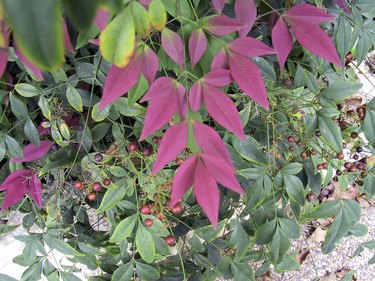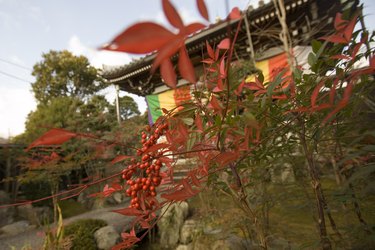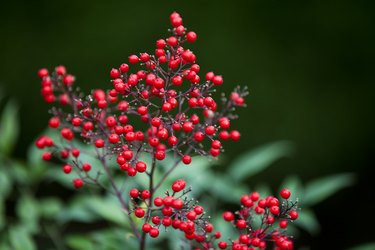
Nandina, also known as heavenly bamboo, is an ornamental shrub featuring cane-like stems and clusters of red berries during the fall and winter. Bright green summer foliage turns red, orange or bronze during the fall when temperatures drop. Nandina grows well in USDA hardiness zones 6 to 9 as a border shrub or in foundation plantings.
Site Selection and Planting
Video of the Day

Choose a spot that will protect the bush from strong winds. Nandina requires full sun, but prefers afternoon shade in extremely hot conditions. The color of the foliage depends on the amount of sun the plant receives. If provided with significant sunlight, the leaves will grow more vibrant in color than if planted in shade. Nandina tolerates most soil types including sandy, loam or clay soil. For best results, provide moist, well-drained, fertile soil. Amend soil with compost to provide additional nutrients to the plant. Add 3 inches of mulch around the plant to prevent weed growth. Nandina can withstand temperatures as low as -10 degrees Fahrenheit, but mulching may help protect the shrub during cold winter weather.
Video of the Day
Watering and Fertilizing

Newly planted nandina shrubs require evenly moist soil. Although fairly drought-tolerant, established shrubs planted in full sun will benefit from occasional watering during extremely hot summer weather. If planted in shade, little watering is necessary. Avoid overhead watering if possible, to prevent the development of fungal diseases. If desired, apply a slow-release fertilizer once a year in the spring. Water the plant well after feeding to prevent the leaves from burning.
Pruning

If not pruned, nandina will grow up to 8 feet tall. Prune nandina once a year in the spring to control the size and shape of the bush. Use sharp, sterilized pruning shears. To encourage full growth, prune back one third of the plant, removing old or weak branches. Cut back single branches any time of the year for use in flower arrangements or wreaths.
Fighting Disease

Although nandina plants are resistant to most pests and diseases, the fungal disease anthracnose may affect them. This disease kills twigs, shoots and leaves, causing rapid defoliation that may eventually result in the death of the shrub. Prevent anthracnose by planting nandina in sunny areas and watering in the morning to allow time for the leaves to dry. If possible, avoid watering the foliage of the shrub. If symptoms of the disease appear, prune back all diseased foliage and dispose of it away from the garden to avoid spreading the disease. Disinfect pruning shears between each cut. Remove any fallen foliage to prevent the disease from over-wintering in your garden. Apply fungicides to the shrub according to the directions on the product you purchase.